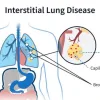Introduction to Interstitial Lung Disease (ILD)
- Interstitial Lung Disease (ILD) is a group of lung disorders characterized by inflammation and scarring of the lung tissue.
- It affects the interstitium, the tissue and space around the air sacs of the lungs.
- ILD can be caused by a wide range of factors, including environmental exposures, autoimmune diseases, and genetic predispositions.
Causes of ILD
Environmental Exposures
- Inhalation of fibers such as asbestos, silica, and coal dust.
- Exposure to toxic fumes and chemicals in certain occupational settings.
Autoimmune Diseases
- Rheumatoid arthritis, systemic sclerosis, and sarcoidosis are examples of autoimmune conditions that can lead to ILD.
- In these diseases, the body’s immune system mistakenly attacks the lung tissue.
Genetic Factors
- Certain genetic mutations and familial predispositions can increase the risk of developing ILD.
Medications
- Some medications, such as certain antibiotics, anti-inflammatory drugs, and chemotherapy agents, have been associated with ILD as a potential side effect.
Infections
- Chronic viral, bacterial, or fungal lung infections can lead to chronic inflammation and scarring of the lung tissue, contributing to ILD.
Other Factors
- Smoking, exposure to secondhand smoke, and certain occupational hazards can also play a role in the development of ILD.
Preventive Measures for ILD
Avoiding Environmental Exposures
- Using appropriate protective gear in occupational settings with potential exposure to toxic substances.
Early Diagnosis and Treatment of Autoimmune Conditions
- Timely management of autoimmune diseases can help prevent or slow down the progression of ILD.
Genetic Counseling
- Individuals with a family history of ILD or known genetic predispositions should consider genetic counseling and testing.
Smoking Cessation and Lung Health Promotion
- Quitting smoking and promoting lung health through regular exercise and avoidance of environmental pollutants can reduce the risk of ILD.
Conclusion and Fitpaa Connection
- The road to preventing and managing ILD involves a combination of environmental awareness, early diagnosis, and proactive health measures.
- Fitpaa’s holistic approach to health and fitness, along with its personalized and technology-driven programs, resonates with the proactive measures needed to prevent ILD and promote lung health.
- For individuals concerned about their lung health and overall well-being, Fitpaa provides a comprehensive solution tailored to individual needs and goals.
Fitpaa App Promotion
Introducing Fitpaa: Your Personal Health & Fitness Companion
- Fitpaa offers a revolutionary approach to achieving health and fitness goals through personalized plans and technology-driven solutions.
Tailored for Indian Users
- Fitpaa’s programs are designed to cater to the specific health and wellness needs of the Indian population, taking into account dietary preferences, cultural factors, and health metrics relevant to the region.
Commitment to Guaranteed Results
- With Fitpaa, users receive not just an app, but a dedicated team of fitness planners, nutritionists, and doctors working towards their specific goals with a 100% guarantee of results.
Access to Fitpaa Essentials
- Fitpaa Essentials, designed to be free forever, provides users with a Fitpaa Capsule based on BMI analysis to support lifelong health and fitness goals.
Risk-Free Trial and Lifetime Validity
- Fitpaa offers a risk-free trial and lifetime validity for goal-oriented services, ensuring user satisfaction and long-term commitment to health and wellness.









